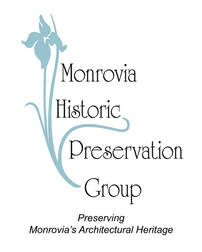About Landmarking
- The city began landmarking homes in April, 1996. Currently, there are currently 161 landmarks, all of them structures except HL# 36 (The Boxx Jewelers clock on Myrtle Avenue, erected in 1914) and HL #159 (The drinking fountain in Library Park, erected in 1909).
- The first home to be landmarked was the Colburn House at 231 N. Primrose Avenue.
- Three landmarked Monrovia structures also appear on the National Historic Register of Historic Places: the Upton Sinclair House (464 N. Myrtle Ave), The Oaks (250 N. Primrose Ave), and the Aztec Hotel (311 W. Foothill Blvd).
Examples of Landmarked Homes
Below is a sample of some of the landmarked homes in Monrovia. To see the entire list, view our Current Landmarks section.
Benefits of Landmarking Your Home
Your Home
Your Neighborhood
Your Wallet
- Formal recognition of the historical importance of your home
- Homeowners may receive reduced fees for building permits
- Option to apply for a Mills Act contract
Your Neighborhood
- Maintains the integrity and rich diversity of the vintage architecture in the city
- Helps protect against future demolition of the house
Your Wallet
- Possible property tax reduction with a Mills Act contract
- Next homeowner can assume the contract, making the home more marketable to prospective buyers
Landmarking Criteria
To qualify for landmarking, the structure must meet ONE or MORE of the following criteria:
- It is identified with persons or events significant in local, regional, state or national history.
- It is representative of the work of a notable builder, designer or architect.
- It contributes to the significance of an historic area, being a geographically definable area possessing a concentration of not less than 50% of historic or architecturally related grouping of properties which contribute to each other and are unified aesthetically by physical layout or development.
- It embodies one or more distinctive characteristics of style, type, period, design, materials or craftsmanship (this criteria is the one most often met).
- It has a unique location or physical characteristics or represents an established and familiar visual feature of neighborhood, community, or the City of Monrovia.
- It incorporates elements that help preserve and protect an historic place or area of historic interest in the City.
- It has yielded or may be likely to yield information important in prehistory or history.
Mills Act Contract
- In 1995 the City of Monrovia made it possible for homeowners to enter into a contract as an incentive to encourage the rehabilitation, maintenance and preservation of designated historic landmarks.
- The contract is a 10 year, automatically renewing, agreement that requires the owner of the property to undertake specific restoration tasks. In exchange for this commitment, the property owner benefits from a reduction in property taxes.
- The property must be landmarked first; it is then relatively easy to get a Mills Act contract.
Steps to Follow for Landmarking
STEP 1
Complete a Historic Landmark Designation Application (available from City Hall or see below)
- Include the following: when the house was built, former owners, architectural description, style of house, etc.
- Pay a filing fee of $500 (the fee for a Mills Act contract is an additional $780). NOTE: These fees were increased by the city, effective August 16, 2014.
STEP 2
The application for landmark status must then be approved by the Historic Preservation Commission and then by the City Council. The entire process takes about six months.
STEP 3
A landmark plaque must be purchased by the owner and placed on the exterior of the home, announcing that the house is landmarked (a $50 reimbursement is offered by MOHPG).
Resource List
Download Application Forms
1. Application to landmark a structure:
1. Application to landmark a structure:
| landmark_application.pdf | |
| File Size: | 62 kb |
| File Type: | |
2. Application for a Mills Act contract (Note: the home must be landmarked to qualify for a Mills Act contract. Generally, landmark designation and Mills Act applications are submitted at the same time.)
| mills_act_application.pdf | |
| File Size: | 73 kb |
| File Type: | |
Do Your Research
The homeowner must provide as much information as possible about the home to be landmarked. To download a suggested list of resources to research that information, click below.
The homeowner must provide as much information as possible about the home to be landmarked. To download a suggested list of resources to research that information, click below.
| resources.pdf | |
| File Size: | 128 kb |
| File Type: | |
Apply with the Department of Community Development (at Monrovia City Hall)
See Sheri Bermejo or Craig Jimenez for information on landmarking/how to proceed with an application.
See Sheri Bermejo or Craig Jimenez for information on landmarking/how to proceed with an application.
